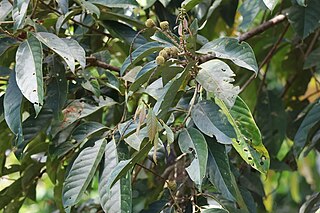Lithocarpus andersonii is a tree in the beech family Fagaceae. It is named for former Borneo Forest Officer James A. R. Anderson.
Lithocarpus bancanus is a tree in the beech family Fagaceae. The specific epithet bancanus is from the Latin, meaning "of Bangka".
Lithocarpus beccarianus is a tree in the beech family Fagaceae. It is named for the Italian botanist Odoardo Beccari.
Lithocarpus bennettii is a tree in the beech family Fagaceae. It is named for the English botanist John Joseph Bennett.
Lithocarpus blumeanus is a tree in the beech family Fagaceae. It is named for the German-Dutch botanist Carl Ludwig Blume.
Lithocarpus bullatus is a tree in the beech family Fagaceae. The specific epithet bullatus means 'blistered', referring to the leaf surface.
Lithocarpus cantleyanus is a tree in the beech family Fagaceae. It is named for a superintendent of the Singapore Botanic Gardens, Nathaniel Cantley.
Lithocarpus clementianus is a tree in the beech family Fagaceae. It is named for Governor Cecil Clementi Smith of the Straits Settlements.
Lithocarpus confertus is a tree in the beech family Fagaceae. The specific epithet confertus means 'crowded', referring to the inflorescences and infructescences.
Lithocarpus confragosus is a tree in the beech family Fagaceae. The specific epithet confragosus means 'uneven', referring to the cupule wall surface.
Lithocarpus conocarpus is a tree in the beech family Fagaceae. The specific epithet conocarpus means 'cone fruit', referring to the acorn shape.
Lithocarpus daphnoideus is a tree in the family Fagaceae. The specific epithet daphnoideus means "like Daphne", referring to the genus Daphne and its leaves.
Lithocarpus dasystachyus is a tree in the beech family Fagaceae. The specific epithet dasystachyus means 'thickly hairy spike', referring to the inflorescence.

Lithocarpus echinifer is a tree in the beech family Fagaceae. The specific epithet echinifer means 'having straight spines', referring to the cupule.
Lithocarpus echinulatus is a tree in the beech family Fagaceae. The specific epithet echinulatus means 'having short spines', referring to the cupule.
Lithocarpus encleisacarpus is a tree in the beech family Fagaceae. The specific epithet is from the Greek meaning "enclosed fruit", referring to the acorns and cupules. The cupule is not fused to the nut though and often becomes irregularly dehiscent. The degree to which the nut is enclosed by the cupule varies across its geographic range. Trees in Lithocarpus are commonly known as the stone oaks and differ from Quercus primarily because they produce insect-pollinated flowers.
Lithocarpus ferrugineus is a tree in the beech family Fagaceae. The specific epithet ferrugineus means 'red-brown', referring to the acorn's indumentum.
Lithocarpus keningauensis is a tree in the beech family Fagaceae. It is named for Keningau District in Sabah, to which the species is native.
Lithocarpus kochummenii is a tree in the beech family Fagaceae. It is named for the botanist K. M. Kochummen.

Lithocarpus lucidus is a tree in the beech family Fagaceae. The specific epithet lucidus means 'shining', referring to the acorn and leaf surface.


